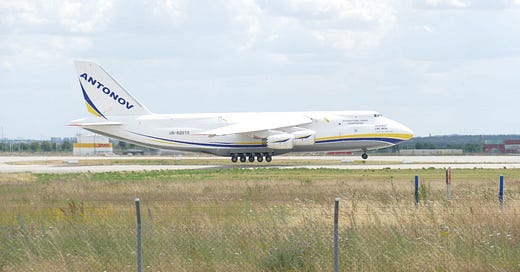How Ukraine Secretly Saved Its 6th Giant An-124 Airlifter
During overhaul, UR-82073 narrowly dodged Russian attacks
On Jan. 4, 1994, workers at the Aviastar factory in Ulyanovsk, 440 miles east of Moscow, put the finishing touches on the Antonov An-124 Ruslan airlifter with the serial number UR-82073. She was one of the last of 37 An-124s the factory built for civil and military users starting in 1985.
This particular An-124, a four-engine airlifter measuring 240 feet from wingtip to wingtip, worked for Russian air carrier Rossiya until landing with its builder, the Kyiv-based Antonov Design Bureau, in 1999.
There were only just 57 An-124s, including dozens made in Ukraine, and several have been lost or grounded after decades of hard work. Roughly the equivalent of the U.S. Air Force’s Lockheed Martin C-5s, the An-124s are among the few planes that can transport extremely heavy and bulky equipment—entire platoons of armored vehicles, for example—between continents.
They’re a precious strategic asset. Russian airlines and agencies still fly a few, and until recently Antonov Airlines flew five, frequently chartering the giant planes to the Ukraine or its NATO allies in order to haul critical defense equipment to Germany for onward shipment to Ukraine.
In a surprise move in broad daylight on July 11, Antonov flew a sixth An-124 from its factory airfield at Svyatoshino in Kyiv to Leipzig, the company’s wartime base. It was serial UR-82073.
In March 2021, on the eve of Russia’s wider war on Ukraine—which would begin 11 months later—UR-82073, later renumbered 0706—was at Antonov’s testing base at Hostomel airport northwest of Kyiv. On March 13, UR-82073 took off for the quick flight a few miles south to Svyatoshino, where she was due for overhaul and upgrade after accumulating 21,000 flight hours across 5,500 sorties.
It was the beginning of a dangerous and inspiring adventure for the 440-ton, eight-crew airlifter. If she had tried leaving a year later, she might’ve been caught in the Russian invasion.
As part of the initial assault on Kyiv on Feb. 24, 2022, hundreds of Russian paratroopers helicoptered into Hostomel. Almost all were killed in two days of hard fighting. But the damage to airfield was extensive. Another An-124 was hit and badly damaged—and the sole six-engine Antonov An-225, the world’s biggest airlifter, was burned to the tarmac.
Secret repairs
UR-82073 wasn’t out of the woods. Secreted inside one of Antonov’s enormous hangars at Svyatoshino, she survived repeated Russian air strikes—including an attack on March 14, 2022 that killed two people and burned a huge hole in the roof of one hangar.
The goal of the modernization, carried out by the Antonov design bureau team, was to replace the main components that were manufactured in Russia with modern components of Western and Ukrainian production,” Antonov explained.
“Due to the full-scale aggression of Russia in 2022, the work was partially suspended: at that time, the aircraft was in a disassembled state,” the firm added. “However, even in the most difficult conditions of war, the Antonov design bureau team was able to resume work and complete the modernization in June 2025.”
By last week, UR-82073 was fully overhauled and upgraded and ready to join the other five An-124s operating from Leipzig. She’d recently survived another Russian air strike—a raid on Svyatoshino targeting the production facilities for the Ukrainian Unmanned Systems Forces best long-range attack drone, the Ukroboronprom An-196.
UR-82073, now wearing her new serial 0706, took off in the late morning from Svyatoshino. People on the ground quickly clocked the lumbering plane. She flew west across Ukraine under radio silence, finally switching on her transponder as she crossed the Ukraine-Poland border at an altitude of 26,700 feet and a speed of 371 knots. It was 1:18 P.M. local time.
If the Russians noticed, they didn’t move to intervene. Ukrainian government and Antonov officials successfully kept a lid on UR-82073’s rebirth for more than three years. “The secret has been well kept!” aviation journalist Gaétan Powis wrote. “The same goes for the evacuation outside Ukraine, with a departure in great secrecy but while still notifying air-defense!”
“The relocation of the Ruslan became not just a technical solution, but a symbol of the resilience, professionalism and unity of Ukrainian aircraft manufacturers,” Antonov boasted. “The improved Ruslan will continue to fly and serve Ukraine on an international route.”
UR-82073 and her five sisters should stay busy, now that the administration of U.S. Pres. Donald Trump has finally consented to large-scale sales of weapons and ammunition to NATO countries for onward transfer to Ukraine.
Whether Antonov will ever repair that seventh An-124—the one damaged at Hostomel in 2022—is unclear. There’s also a damaged Antonov An-22 transport at the airfield.
Read more:






